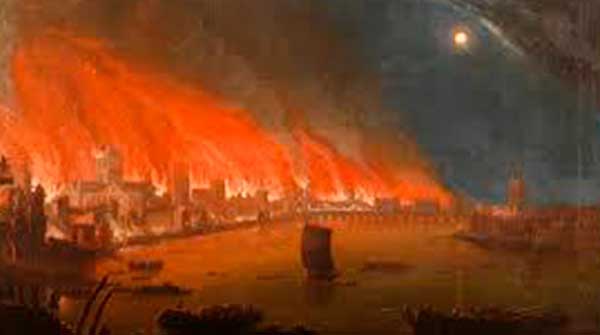Charles II’s leadership during the Great Fire was the kind of performance that gives kings a good name
 In the early hours of Sept. 2, 1666, the Great Fire of London ignited in a baker’s shop in a little street called Pudding Lane. It spread havoc over the next four days, laying waste to the old walled city at the centre of London.
In the early hours of Sept. 2, 1666, the Great Fire of London ignited in a baker’s shop in a little street called Pudding Lane. It spread havoc over the next four days, laying waste to the old walled city at the centre of London.
By the time the fire was extinguished, more than 13,000 houses and 87 parish churches had been destroyed. Gone too was the medieval St. Paul’s Cathedral. Gothic in architectural style, it had been among Europe’s most impressive religious edifices.
The death toll, fortunately, was smaller than you might imagine. But although official counts are in single digits, the intense heat and the propensity for bodies to be cremated in such a fire means that the precise number will always be unknown.
Then there was the matter of homelessness: estimates put that number at around 100,000 people.
 |
| Related Stories |
| Was Oliver Cromwell the Great Satan?
|
| The death of King Richard the Lionheart
|
| England’s warrior queen
|
Just the previous year, London had been devastated by plague, which was reckoned to have killed about 70,000. And for a city still settling in to a restored monarchy after more than a decade of non-royal rule, this one-two punch was a potential destabilizer.
Realistically, the fire was an accident waiting to happen.
Given its primarily timber construction, thatched roofs, narrow streets and overhanging second storeys, the city was a tinderbox with little by way of natural firebreaks. Stir in the effects of a long, dry summer and a strong east wind and once the blaze got going, stopping it was going to be a real challenge.
To make matters worse, the immediate reaction from the Lord Mayor was dilatory and dismissive. “A woman,” he said, “might piss it out.” But it took a lot more than that to do the trick.
After peaking on Sept. 4, the inferno was eventually brought under control. This was partly luck and partly down to human action.
The luck came courtesy of nature. The strong east wind abated and changed direction.
The human contribution could be characterized as desperation spurring inspiration. When initial efforts at pulling down houses to create firebreaks had disappointing results, the process was significantly enhanced by blowing them up with gunpowder.
The fire also posed a personal danger for Charles II. Just six years on the restored throne after being in exile, he was always wary of the fragility of his position. As he put it, he “did not wish to go on my travels again.”
So he did the smart thing. Rather than simply being his people’s sovereign, he acted as their protector.
Charles ordered house demolition to create firebreaks, inspected the damage, personally threw water on the flames and put his brother – the future James II – in charge of street operations. It was the kind of performance that gives kings a good name.
Charles also took steps to counteract the street violence that comes naturally in panic-stricken scenarios like this.
As xenophobic as any other 17th-century Europeans, Londoners were susceptible to rumours of sabotage and conspiracy. The fire, it was said, was deliberately set and fanned by foreigners and traitors. The French, the Dutch and Catholics in general were the prime suspects.
It’s not difficult to see why such feelings found a receptive audience. England was at war with the Netherlands and France in September 1666. This was an era of European-wide religious intolerance, where the separation of church and state was an unknown concept. And it was less than a century since the Vatican had issued Regnans in Excelsis, effectively calling for the overthrow of Elizabeth I.
But Charles had particular reasons to be sympathetic to Catholics. His wife, mother and brother were open adherents of the faith, and he was probably a closet Catholic. In any event, he came out swinging: the fire was an act of God and there were no plots “by Frenchmen or Dutchmen or Papists,” he said.
Still, old grievances die hard. Many people didn’t believe the king, and it wasn’t until 1831 that the inscription blaming “the treachery and malice of the Popish faction” was effaced from the monument built to commemorate the fire.
Troy Media columnist Pat Murphy casts a history buff’s eye at the goings-on in our world. Never cynical – well, perhaps a little bit.
For interview requests, click here.
The opinions expressed by our columnists and contributors are theirs alone and do not inherently or expressly reflect the views of our publication.
© Troy Media
Troy Media is an editorial content provider to media outlets and its own hosted community news outlets across Canada.


